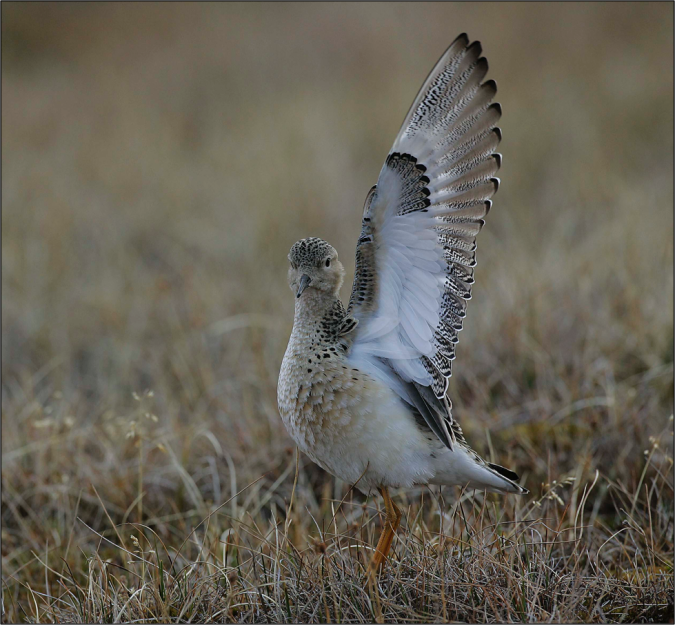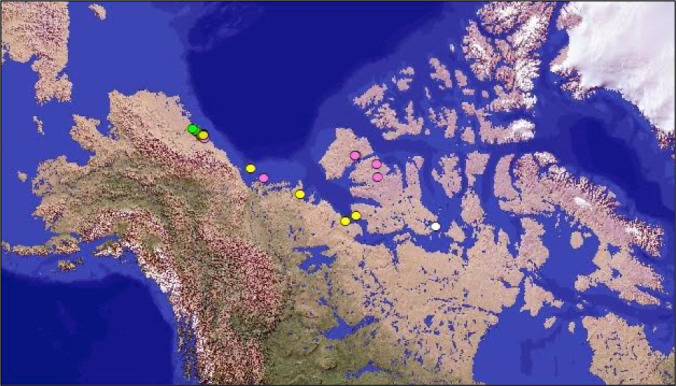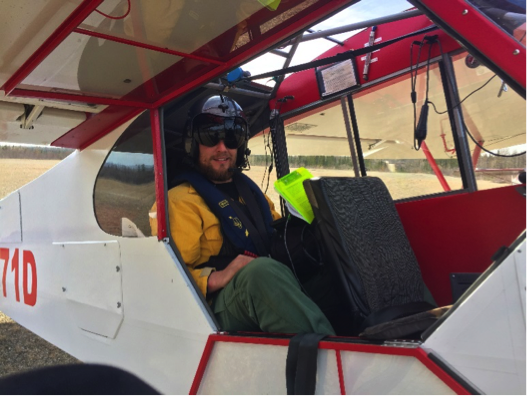Buff-breasted sandpipers, or buffies, are an unusual species of shorebird. Males defend small territories on leks, where they court females through an elaborate wing display. Based on this display or perhaps the spotting on the males wings, females select a mate, copulate, and then leave to nest on their own.

Single-wing display of a male buff-breasted Sandpiper. Photo courtesy of Ted Swem.
Buffies are long-distance migrants that breed in the Arctic and winter in the coastal regions of Argentina, Uruguay, and Paraguay. The species is listed as Near Threatened on the International Union for Conservation of Nature list and is on the U.S. Fish and Wildlife Service’s Birds of Conservation Concern 2016 list. In collaboration with the Migratory Bird Management Division of the U.S. Fish and Wildlife Service, we trapped male buffies in northern Alaska on their leks and attached tiny GPS satellite transmitters to determine where they go after the breeding season. We could only equip males with transmitters as the females are too small to successfully carry the tags. Very little is known about how Buff-breasted Sandpipers use the Arctic coast (e.g., if and where stopover sites occur), although it is thought they remain in the high Arctic for more than a month prior to migrating south through the center of North America. Information on shorebird movements and habitat use along the Arctic Coast is critical to conservation planning and implementation. Baseline data are essential to evaluate how changes in coastal areas are affecting shorebirds, especially because the Arctic coast will continue to change due to sea level rise and greater erosion during the late summer and fall open ice season, and receive lower levels of siltation of river deltas as glaciers recede. The lack of baseline data makes it difficult to assess the potential effects, especially cumulative effects, of industrial development that is changing the Arctic coast.

12:30AM. Two biologists hold a mist net between two poles and attempt to drop it over a displaying buff-breasted sandpiper. Capturing birds is difficult unless males are distracted by avian predators flying overhead or females visiting their display sites. Photo credit: Devon Short, WCS.
Only one month after tagging, some of the male buffies have moved east all the way to Banks and Victoria Islands. It will be very exciting to find out where they go next. Our transmitters will hopefully continue to provide GPS-quality location data until mid-August by which time the birds will have reached Texas as they travel toward their South American wintering areas…or points as yet unknown!

1:00 AM. Taking measurements and attaching a satellite transmitter. Photo: Rebecca Bentzen.
This locational data on Buff-breasted Sandpipers is part of a much larger effort to assess shorebird use of coastal sites by many other species. Once all the location data is collected, we can ascertain the relative importance of coastal sites to shorebirds overall, aiding managers in assessing potential issues for current and future developments. We will also learn much more about how this and other species travels across the Arctic and during their southbound travels within North, Central and South America. Where necessary, conservation actions can be initiated at the most important sites rather than guessing where conservation funds can best be spent. Such targeted efforts will lead to increased conservation success.
This project is a partnership between Manomet Inc., the U. S. Fish and Wildlife Service, the Wildlife Conservation Society, the U.S. Geological Survey, and BP Alaska Inc. Major funding was provided by the National Fish and Wildlife Foundation, and by donors to Manomet.

Map showing the movements of male buff-breasted sandpipers tagged at Prudhoe Bay, Alaska in June 2017.
Written by Rebecca Bentzen, Avian Biologist, Arctic Beringia Program, Wildlife Conservation Society. July 2017.



